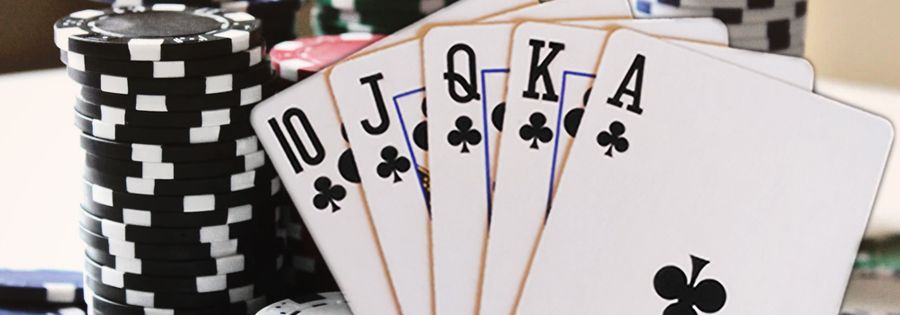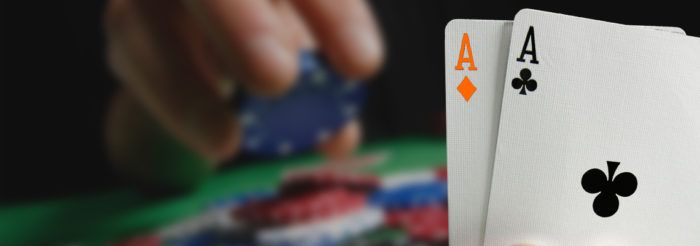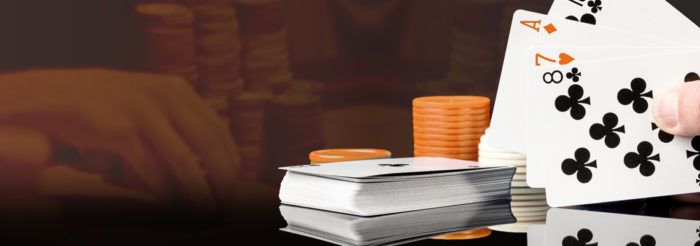Chapter 2: Poker Hands
Even if you’re a poker novice, you’ll likely already be aware of some of the more well-known winning poker hands. As soon as you enter a casino, it won’t be long before you begin hearing the familiar names of the hands that have been depicted countless times in popular culture.
‘Straight flush’, ‘full house’, and ‘royal flush’ instantly evoke images of high rollers, high stakes, and high jackpots. However, those who are not experienced poker players might not understand what these hands actually mean.
Whether you’re playing poker online or in a land-based casino, knowing the game inside and out is crucial for success. Putting together a winning poker strategy requires being able to know all of the possible ways you can win, which means knowing your poker hands like, well… the back of your hand.
With that in mind, let’s dive into this authoritative guide on all of the poker hands you could ever need to know, and how they can help you win.
What you’ll find on this page
Poker Hands Explained
Whether you are playing poker at a land-based casino or a live casino, you will find that the rules of the game are generally governed by the same set of hands. Whether you are playing against the ‘house’ or against other players at the table, your chances of winning the jackpot are determined by how strong your hand is. Here are the poker hands that you need to know, in order of their strength.
Royal Flush

This is the strongest hand you can possibly get in a standard game of poker. If the hierarchy of the game is based on the ‘highest’ or strongest hand winning, then a royal flush will win outright every time. To get a royal flush you need to have a hand consisting of a 10, a jack, a queen, a king, and an ace.
All need to be from exactly the same suit (i.e. all hearts or all clubs). It is, generally, extremely rare to get a royal flush in a game of poker. In a standard 52-card deck game, the odds of getting a royal flush are 649,739 to one. This is equivalent to a 0.000154% chance of being dealt a royal flush each round.
Straight Flush
The straight flush is one of the most iconic poker hands in existence. Films such as Viva Las Vegas and Casino have depicted characters winning the day and blowing all of their opponents at the poker table away by revealing a straight flush.
To secure one, you need to have five cards in a chronological numerical sequence, all of the same suit. An example of this would be a five, six, seven, eight, and nine, all diamonds. The odds of getting a straight flush in a round of poker equates to 37,260 to one, or 0.0279%.
Four of a Kind
Whether you’re playing Texas Hold ‘Em at a casino online or in a land-based casino, a four of a kind hand is pretty difficult to beat. As you might have guessed, a four of a kind hand consists of a hand in which you have four cards that are all of the same number or type. This could be four twos, or four kings, or four aces.
If you do have a four of a kind hand, it is important to remember that you can still be beaten by another four of a kind hand (or a straight or royal flush). Say you have four twos. If another player at the table has four eights, then they will be the overall winner in a standard poker game, because their cards rank ‘higher’. The odds of getting a four of a kind in a five-card game of poker are around 4,165 to one, or 0.024%.
Full House
A full house is another classic poker hand that you may already be familiar with thanks to the countless depictions of the hand on film and TV. In some variants, a full house is also called a ‘full boat’, but the rules are exactly the same. To win a full house in a five-card hand game, you need three cards of the same kind (i.e. three sevens) as well as two different cards of the same kind (i.e. two nines).
Much like with four of a kind hands, there are different hierarchies of a full house. Basically, the full house with the ‘higher’ ranks of threes always wins the round. For example, if you hand one full house that consisted of three fives and two aces, this would be beaten by another hand that consisted of three sevens and two aces. The odds of securing a full house in a game of five-card hand poker are 693 to one, or around 0.1441%.
Flush
This is a more commonly found hand that is one of the strongest that you are likely to come across in a game of poker. Basically, a flush is an easier to get version of a straight flush. A flush is when you have five cards that are all from the same suit, but they are not in any kind of chronological sequence.
For example, if you have five cards that were all diamonds, but did not form a sequence, then you have a flush. An example of a flush would, therefore, be a queen, a two, a five, an ace, and an eight of diamonds. The odds of obtaining a flush in a standard five-card game of poker are 509 to one, or about 0.367%.
Straight
As you might have figured out already, a straight is a straight flush without the flush. It is when you have a hand of cards that creates a chronological numerical sequence, but they are not all from the same suit. An example of this might be an ace of spades, a two of clubs, a three of diamonds, a four of hearts, and a five of spades.
Like the other hands mentioned here, the best straight hand at the table is one that, in a typical game, ranks the highest. Therefore, the hand we have just described would be beaten if someone else at the table held a four of diamonds, a five of hearts, a six of spades, a seven of clubs, and an eight of diamonds.
Remember, regardless of whether aces are high or low, rollover sequences are not permitted. This means you could not describe a hand as ‘straight’ if it consisted of, say, a king, a queen, an ace, a two, and a three. The odds of getting a straight in a five-card game of poker are 253 to one, or about 0.76%
Three of a Kind
This one is fairly self-explanatory. A three of a kind hand is simply any hand in which you have three cards of the same number or value. Therefore, a hand which had three aces, and two other, different cards, such as an eight and a four, would be classed as a three of a kind hand. If the other two cards in the hand form a pair, then the hand becomes a full house.
Again, the success of a three of a kind hand is determined according to numerical order. That’s why a ‘trip aces’ (three aces) hand always beats a ‘trip queens’ (triple queens) hand because aces rank higher than queens. On average, a three of a kind hand will be dealt out once every 47 times when dealt at random from a 52-card deck. This translates to odds of around 46.33 to one, or about 2.1128%.
Two Pair
Now we are entering the realm of fairly common and frequently occurring hands that can still help you win a game of poker. As the name suggests, a two pair is when you have two different pairs of cards of a particular number or value.
An example would be a five-card hand that consists of two sixes, two jacks, and a fifth card that does not have any connection to the pairs, which in this case would be a three, for instance.
In a situation where there are multiple players that have two pairs, the player with the higher pair wins. Therefore, if a player with the hand described above had to face off against a player with two pairs of which one pair was two kings, the latter player would win outright. The odds of getting two pairs in a standard game of poker are about 20 to one, or about 4.7539%.
One Pair
A one-pair hand is any hand in which you have a single pair of cards of the same numerical or face value, but the other three cards cannot form any other type of combination or hand. An example here would be a five-card hand that consisted of two fives, and then an ace, a seven, and a queen. It is extremely commonplace for one-pair hands to be drawn in poker, as 42% of all hands will have at least one pair.
That’s why it is important to know how the winner is decided among competing one-pair hands. Just like the other hands described, it is typical that the ‘highest’ pair is always the winner. Therefore, if a player had a hand with one pair of eights, they would beat the hand described above. The odds of drawing a one-pair hand in a standard game of poker is 1.366 to one.
High Card
When playing casino poker, the high card hand basically describes the lowest you can go. It is a hand where none of the cards form any kind of winning sequences whatsoever. An example would be an ace, a four, a ten, a six, and a king, of varying suits.
If multiple players manage to draw a high card, then whichever one holds the highest card is typically chosen as the winner. Therefore, the hand described above would win the round if the other player did not also have a king (or an ace). If neither player has a higher card than the other, then both are declared winners and the jackpot is split equally between them.

Different Poker Hierarchies Explained
Before you step up to the poker gaming table at an online casino, it is important to know that the hand hierarchies actually vary depending on what variation of poker you are playing. Here’s what you need to know about casino poker hierarchies.
Classic Poker Variations: Texas Hold ‘Em, Omaha, Seven-Card Stud, Five-Card Draw
In any of these games, the hand rankings are ordered according to exactly the same order in the list above. A royal flush is the best possible hand, while one-pairs and high cards are the worst. Straights and flushes are described as above and rank in the same order as above, with flushes always ranking higher than straights.
Split Poker Variations: Omaha Hi-Lo, Stud Hi-Lo
In split poker variations, the rankings are almost completely the same, with one crucial difference. In hi-lo poker variations, half of the jackpot always goes to the lowest hand, while the other goes to the highest hand. This means that both a royal flush and a one-pair offer virtually the same chance of success. Some hi-lo variations might count high card hands as winners, but not all.
Lowball Poker Variations: 2-7 Triple Draw, Razz
These are essentially the reverse of the ‘classic’ poker hierarchies. This means that only the lowest ranking hand combination will win. In these games, a royal or a straight flush is essentially a losing hand, while a one-pair hand with the lowest ranking pair would be classed as a very strong hand. In razz, straights and flushes don’t count for anything at all. Meanwhile, in 2-7 straights and flushes count against you and will weaken your hand.
Three-Card Poker
Since three-card poker consists of smaller hands, the rules and rankings differ somewhat. All of the winning hands are simply three-card versions of those described above. Therefore, a royal flush could be a jack, a queen, and a king of hearts. Additionally, straights and flushes are reversed in three-card poker, meaning that a straight will always beat a flush.
This is everything you could ever need to know about the different types of poker hands. Next time you’re playing at the online casinos, whether it’s a live casino poker or not, you will know exactly what to expect.








